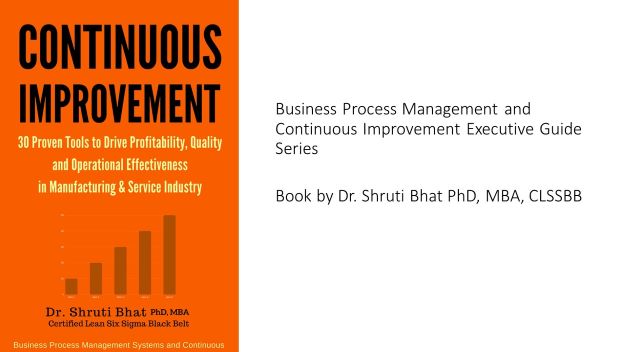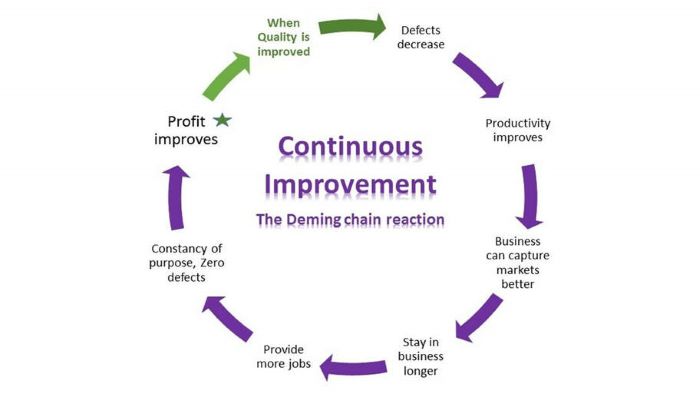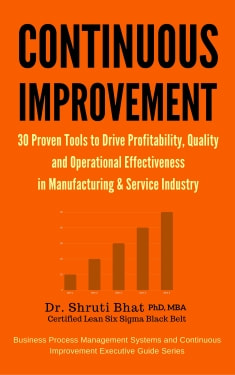Businesses however big or small, can sustain only if they adapt themselves to changing market dynamics, economy seesaw and customer demands. This, very sustenance is affected by five main factors namely- people, money, machines, processes and materials. Processes being the most critical factor, which I term as ‘Business Lifeline’.
For Continuous Improvement efforts to be meaningful, cost-effective, realistic and sustainable, one must use effective and accurate tools that will facilitate- identification of the business problems, augment strategic decision-making & implementation, help problem-solving, support measuring the change & sustaining process excellence.
This book provides deep insights into thirty vital tools necessary to meet success with your Continuous Improvement campaigns.
What will you learn from this book?
This book covers the following topics –
- Thirty important Continuous Improvement tools- Value stream mapping, Process benchmarking, Root cause analysis, 8D methodology, Process mapping, Affinity diagram, Swimlanes, Prioritization matrix, Auditing, Fault tree analysis, Reliability block diagram, Flow chart, Block diagram, Activity diagram, Conceptual data modeling, SWOT analysis, Workflow design, FMEA, Process decision program chart, Pie chart, Statistical methods (viz. Mean, Median, Mode, Check sheet, Pareto chart, Histogram, Run chart, Control chart, Scatter diagram), Policy deployment, Brainstorming, Mind mapping, CTQ trees, Cause-and-Effect diagram, PERT diagram, Gantt chart, Investigational interview techniques viz. 5 Whys, Causality, Socratic method, 5Ws 1H & Why-because analysis and Kamishibai boards.
- How to construct and strategically use these tools during all the phases of a Continuous Improvement campaign.
- Advantages, limitations and applicability of each tool at your workplace.
- Illustrative examples of using these tools during your Continuous Improvement campaigns and post face.
- Possible roadblocks on Continuous Improvement highway that champions needs to watch out for, how to tap into these tools as a vital resource to overcome roadblocks and/or prevent detours.
Who should read this book?
This book presents practical ways to build and improve business processes and assists professionals whether they are learning the basics of Continuous Improvement, planning their first improvement project, or evangelizing process-oriented thinking throughout their organization.
This book is for all professionals involved in decision-making, directing their organization’s sustainability, profitability, and expansion. If you want some new and effective ideas for improving your organization's efficiency, then this business management book is for you.
Chapter 1:
The Deming’s quality cycle is never ending. It is a strategy used to achieve Breakthrough and Continuous Improvements in safety, quality, morale, delivery cost and other critical business objectives. The completion of one cycle continues with the beginning of the next.
The success of any Continuous Improvement campaign relies on following four types: tools for data gather, tools for problem-solving, tools for decision-making, tools for strategic implementation of the campaign, tools for measuring the change and assessing ‘change is indeed an improvement’. This book presents tools belonging to all these four types.
Before exploring the specific tools, let us start by having a quick look at what is involved in improving a business process.
A business process can be anything from a process of procuring material, at the production line or serving a customer. There are three principal or key areas for process improvement, which contribute to the profitability and effectiveness of an organization. These are-
- Reduce waste (for a manufacturing company) and/or reduce time taken to see a customer (for a service organization).
- The way a job is done.
- The way any process is under taken.
To improve any one of these we need to:
- Observe all our actions and the consequences.
- Record what is observed in detail.
- Analyze the results and take corrective and preventive actions for errors.
Business management team in any organization, worldwide, has two sets of problems: those of today and those of tomorrow on the supposition that there is a tomorrow for the company that hopes to stay in business.
To thrive, succeed and grow, the business must constantly improve productivity, product/ service quality and overall organizational effectiveness. Moreover, it is vital to note that, Productivity improvement should not be more production at the cost of more people losing jobs. Rather, productivity improvement should be win-win scenario for the business and its employees and the whole community.
Productivity improvement should actually change the character of departments. New way of doing things should mean, more work gets done by the same number of people now trained to do their jobs better, new skills.
Similarly, Quality comes not from inspection, but from improved business, production and/or service processes. Total quality control means- quality of work, quality of service, quality of products, quality of information, quality of process, quality of division, quality of people, quality of company, quality of objectives and quality function deployment. Quality tools cannot remedy every quality problem, but they certainly facilitate problem solving.
There is increasing recognition that Continuous Improvement offers more than just operational improvement in performance. If Continuous Improvement efforts can be sustained over the long term, the opportunity exists for considerable strategic advantage, as organizations move on from bringing and maintaining their processes in control to improving them and developing totally new ones.
Recent survey data suggests that 65% of companies consider Continuous Improvement to be strategic importance and around 50% have instituted some form of systematic program to apply these concepts.
A further 19% claim to have a widespread and sustained process of Continuous Improvement in operation and of those firms using Continuous Improvement, 89% claim it has had an impact on productivity, quality, delivery performance or a combination of these- such is the power of Continuous Improvement !
To improve a process, you need to have a clear picture of what is ‘actually’ happening, not what you ‘think’ is happening or what is happening in ‘theory’; but how the process is actually working.
Therefore, tools are essential ingredients of a process and basic instruments for the success of a business process Improvement program. Many companies have used tools without giving enough thought to their selection and have then experienced barriers to progress.
So, how do you choose the correct tool? Choice of tool will depend on-
- What do you want to measure?
- What do you want to achieve?
- What form does the data take?
- What do you want to do with the results?
End of Preview
Grab your copy of this book Now! |
About the author: Shruti Bhat PhD, MBA, CLSSBB
Follow Shruti on Twitter, YouTube, LinkedIn
Keywords and Tags:
#DrShrutiBhat #Lean #ProcessExcellence #ContinuousImprovement #Kaizen #QualityImprovement #Innovation #Quality #eLearning #Business #BusinessProcessManagement #ServiceIndustry #ManufacturingManagement #LeanInnovation #Pharmaceutical #LifeScience #Food #Beverage #Biotechnology #Retail #Cosmetics #PersonalProducts #Chemicals #Drugs #Engineering #BPM #LeanManagement #KaizenMasterclass #LeanSixSigma #Kanban #FMEA #RiskManagement #Speaker























